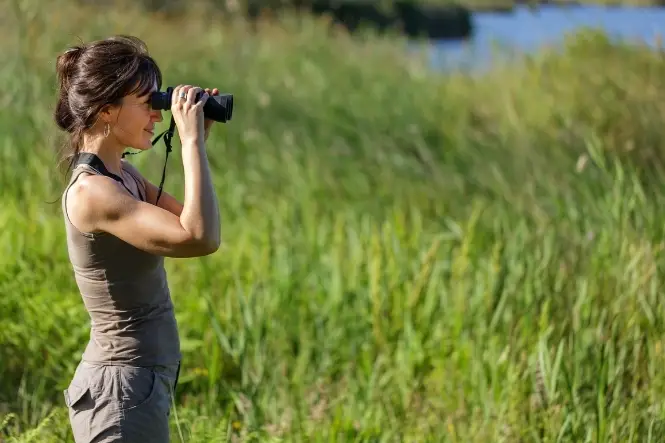Half the enjoyment of creating your own wild area in the garden comes from the chance it gives you to watch some of our native wildlife and while you often need nothing more than a keen pair of eyes, there are times when a little extra equipment can help.
Binoculars
Binoculars are one of the most useful instruments in the wildlife watcher’s armoury, allowing you to make close, careful and unhurried observations of some of our most shy native creatures at a distance that won’t alarm them – and most people find them less of a strain to use for long periods than a telescope. Although we tend to think of binoculars for watching birds or mammals, they can be just as useful for insects and even wildflowers, given the right circumstances – and with today’s optics and lens quality, the clarity of view you can get is quite amazing.
The two key factors are magnification and light gathering ability – which affects how ‘bright’ the image appears and how much you can see in dull weather or as it begins to get dark – and binoculars are often described in terms of these. You’ll see the likes of 8 x 30, or 10 x 40 – the first number referring to the magnification and the second giving size of the objective lens (that’s the one nearest to your target). As a general rule, the larger that second figure is, the brighter the image will be.
Focusing distance is another aspect to take into account and many models tend to be able to focus very close – some down to around a metre – which can make them very useful for watching active insects and the like.
You might reasonably think that the bigger the magnification, the better, but that’s not entirely true. Granted, you will see further, but because the area you’re looking at is so much smaller, high-magnification binoculars can make finding your subject quite difficult in the first place. As with so many things, the ‘best’ choice depends on a bit of a compromise. Most bird watchers agree that a magnification below 7x doesn’t bring you close enough to your bird and above 10x, it’s difficult to hold your binoculars steady enough to get a good view; unsurprisingly, 8 x 30 or 8 x 40 binoculars tend to be the most popular choice.
Choosing your binoculars comes down to a balancing act between price, performance and intended use – though inevitably personal preference is the major deciding factor. The most expensive are not automatically always the best – either for your purpose, or in terms of performance – but as a general rule, you do largely tend to get what you pay for. Picking the right binoculars is not a simple task and it’s a good idea to ask around for advice, do your research and try out a few pairs before making your final choice. It’s an important investment, so it’s worth taking the time to get it right.
Cameras and CCTV
A good camera is another really useful tool to have at your disposal and with the rise of digital photography, there’s no shortage of reasonably priced models with excellent zoom lenses that will allow you to make a very good record of your sightings. This obviously lets you keep a permanent souvenir of your visitor – but where it really comes into its own is in identifying those unusual or unknown creatures that may drop by, from time to time. If you manage to get a clear picture, you’ll find sitting down with a guidebook to try to work out what it was, is much easier than trying to rely on your memory alone – however good it may be!
Some wildlife gardeners have taken this idea one step further and installed CCTV systems, coupled to recorders, so that they need never miss a moment. With the right equipment, this can be an excellent way of watching the antics of nocturnal or particularly shy animals, and with the added bonus that you get to see them behaving naturally, unaware they’re being filmed. More than a few enthusiasts have set up web-cams to share the experience unfolding on their own back lawns with a literally world-wide audience.
Hides
If you can’t get a good enough view from your house, one option to consider is a hide of some sort. There’s a good selection of purpose made ones available, although most of these are portable and intended to be used on field trips rather than as year-round fixtures in the garden. Alternatively, if you do want something more permanent, and a little more comfortable, it’s fairly simple for anyone with even modest DIY skills to modify a cheap shed to suit.
Wildlife gardeners have an unparalleled opportunity to observe wild creatures first hand and with the right equipment, they can be sure to make the most of it!

